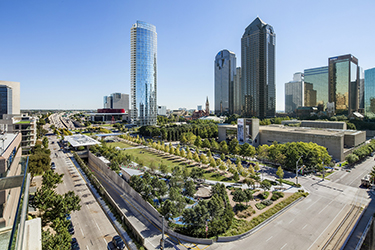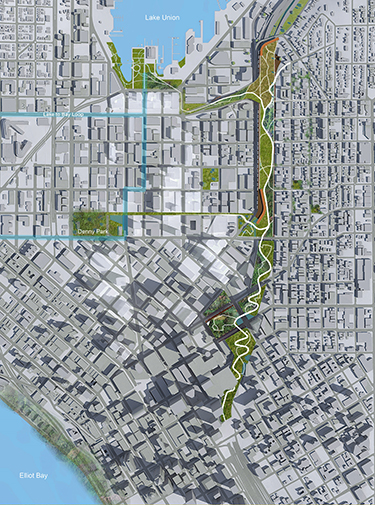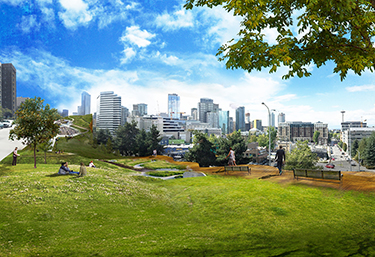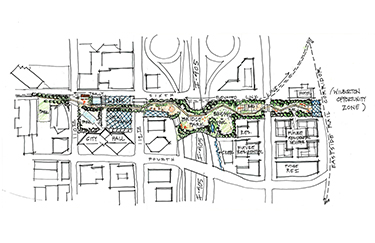|
Subscribe / Renew |
|
|
Contact Us |
|
| ► Subscribe to our Free Weekly Newsletter | |
| home | Welcome, sign in or click here to subscribe. | login |
Architecture & Engineering
| |

|
|
Design Perspectives By Clair Enlow |
June 29, 2016
Design Perspectives: Can we put a lid over our urban freeways?
Special to the Journal
Freeway construction is so 20th century. Now, the idea of ripping a huge gash through neighborhoods and blighting acres of urban land is a non-starter.
We're recovering from our paving spree, and building cities instead. But we're hooked on our freeways because they provide important regional connections and access to downtown and in-city neighborhoods.
Can we have our fast lanes, and erase them, too? The short answer seems to be a resounding yes — especially if we don't have to dig.
A presentation and panel discussion this month sponsored by ULI Northwest featured four lidding projects. Two are completed, in other cities. And two local ones — over Interstates 5 and 405 — are still in the dream stage.
Lidding as a remedy
Seattle's current freeway–erasing experiment (putting state Route 99 into a deep bored tunnel) involves a lot of digging. Its estimated completion has already been delayed by years, and so has the city-building part of the project.
The more practical solution to the freeway gash is lidding. Strategic lids could be the ultimate urban infrastructure — an extension of the land itself, right over the freeway. They could be combined with buildings, or just provide needed open space.
Maybe the most successful of these traffic-hiding projects is in a freeway-centric part of the world, Texas. The designer of Dallas's Klyde Warren Park, James Burnett of The Office of James Burnett, was the keynote speaker at the ULI Northwest event. The park, completed in 2012 on a deck over the Woodall Rodgers Freeway, is now the heart of the city. It's a magnet for people, even on hot summer days and evenings.
Admittedly, Dallas's park was in a spot just begging for a lid — a section of connecting freeway already in a trench, with civic landmarks on each side. It got structural reinforcement, including a mid-line wall, but there was just enough room for the at-grade deck, with plantings. It's topped with a restaurant, along with active and passive park space, including a water feature.
Isn't lidding expensive? Not really, according to Burnett, compared with other types of infrastructure like highway interchanges — and even buildings like convention centers and arenas. He broke down the funding for Dallas's five-acre lid and park, which was built for about $110 million. The Texas Department of Transportation (yes, the state) kicked in $20 million to get things going, matching an equal amount in local fundraising. Then, as a shovel-ready project during the Great Recession, the lid got federal stimulus money to get it through construction. It all took a decade, from the idea to the beginning of design to completion in 2012.
That fits general estimates of lid costs, which are in $18 million to $20 million-per-acre range, according to Seattle architect and lidding proponent Christopher Patano, who also spoke at the ULI Northwest event.
Lessons learned
The timing and the circumstances aren't always as good as they were in Dallas.
Boston had to dig, a lot, to put its Central Artery into a 1.5-mile trench and lid it. The Big Dig is the granddaddy of long freeway lids. The Boston team finished the project in 2006 after spending three decades on it (including planning), and going several billions over budget. But now the city is reconnected with its waterfront, and breathing much easier.
Rebecca Barnes, another speaker at the ULI event, was on the project team for the design of the freeway-spanning Washington State Convention Center. Later she moved to Boston, holding leadership positions with the Boston Redevelopment Authority and overseeing the design of landscaping on the lid over the Big Dig, now known as the Rose Kennedy Greenway. Barnes is now university architect and campus planner at the University of Washington.
Remembering the changing city administrations and enraged citizenries in Boston, Barnes had some advice for cities contemplating a lidding project: “It needs to be politics-proof.”
In Boston, Rose Fitzgerald Kennedy Greenway Conservancy, a charitable non-profit, brought fundraising capability and leadership continuity for the project, and the result is a swath of green space and public amenities in the center of Boston. Other cities — including Seattle — have taken note, with non-profits such as Friends of Waterfront Seattle coalescing around projects like the redevelopment of Seattle's Central Waterfront.
Patano is hopeful that Seattle will move more swiftly to grow some more lidding over Interstate 5. He and members of his downtown Seattle design firm Patano Studio Architecture — some of whom walk to work across the freeway from Capitol Hill — have an idea called the Seattle C.A.P. In their spare time, they've produced graphics showing a 45-acre lid over I-5.
It would stretch from the convention center area and Freeway Park into the South Lake Union area, rising as it does. It would blend in at grade on the uphill side along Capitol Hill. Over the freeway, the lid is like a shelf — above traffic high enough to admit light and accommodate some suggested companion projects, including a basketball arena.
So far, basketball arena proponents have not talked with Patano, but the lid has support, he said — especially on Capitol Hill and among proponents of a strong Pike-Pine corridor through downtown.
Patano agrees that his idea for lidding I-5 through Seattle carries a lot of baggage — past projects and dreams that add more weight than support. His team won second place in a design competition for the Seattle Commons, a grand park project in South Lake Union that voters rejected in the 1990s.
Freeway Park, which spans I-5, has been scorned by neighbors who called it a haven for crime. Activating and policing the iconic park has helped.
But now we know a better way to do a lid, said Patano. “It has to be wide open.” It also has to blend in with the city at the edges, something that Klyde Warren Park does very well. James Burnett has some advice for an I-5 lid: “You've got to be very surgical,” he said. And persistent. “I see it being a 25-year project.”
A great pedestrian experience
The next freeway lid around here is likely to be in Bellevue. The proposal is more modest than Patano's, and the idea came from the Bellevue City Council, according to Bellevue's planning director Dan Stroh, and the city has selected a design consultant for the “visioning” phase, Balmori Associates of New York City.
The lid is part of a larger proposal called the Grand Connection, a long green swath of pedestrian infrastructure. It would stretch from the north-south lying Eastside Rail Corridor on the east side of Interstate-405, across the freeway and all the way past Bellevue Square to the shore of Lake Washington on the west.
Like the plan for redeveloping the Seattle waterfront, it includes a mix of open space and dedicated pathways for pedestrians and bicyclists. It's pitched as an economic development project that will boost the renewal of Bellevue's old auto row neighborhood on the east side of the freeway, and attract more desirable employers like REI, which will make it's headquarters in the nearby Spring District on the east side of I-405.
The size of any lid in Bellevue is yet to be determined, but the northern edge is likely to be near the span of the bridge carrying Sound Transit's East Link across I-405. The lid deck would span a wide chasm there, but it can tie in easily with the street grid, just as bridges now do there, every two-to-four blocks. If you've driven these east-west bridges in Bellevue, you've probably not seen a pedestrian or even noticed a walkway. They're just not inviting. “None is a great pedestrian experience,” said Stroh.
As for the Grand Connection, he said, “What we are going to have here is a great pedestrian experience.” In the decades to come, it's likely that many more cities like Seattle and Bellevue will literally get over their freeways. Someday, with the Grand Connection in place, crossing I-405 will be just another event for people walking or bicycling across town. They may have a great view of many, many cars — all moving slower than themselves.
Clair Enlow can be reached by e-mail at clair@clairenlow.com.
Previous columns:
- Design Perspectives -- District energy: Lots of talk, but still little action, 06-08-2016
- Design Perspectives: New paths and parks make Yesler Terrace shine, 05-04-2016
- Design Perspectives: Cities improving streets with paint, and political will, 04-06-2016
- Design Perspectives -- WSCC expansion: So what's inside the box?, 03-09-2016
- Design Perspectives: UW eyes 8 million square feet of new buildings, 02-17-2016
- AIA winners manage to surprise and inspire, 11-18-2015
- Design Perspectives: 2&U tower's design team attempts a heavy lift, 11-12-2015
- Design Perspectives: Budapest, Vienna offer lessons on planning and war, 09-30-2015






